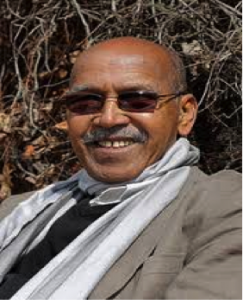By

Hiding in Plain Sight” begins with a threat. One evening in Mogadishu, Aar, a logistics officer for the United Nations, receives a letter in the mail. It consists of a single, misspelled word, but it’s terrifying all the same: deth! Aar wants to return to his home in Nairobi on the first flight out, but at the last minute, he decides to stop by the office to pick up photos of his children. As he steps out with the pictures in hand, Shabab militants strike the building.
A terrorist attack is a difficult place to start a novel. The writer must compete with a flood of words and images, most of them clichés. But the Somali novelist Nuruddin Farah is used to the challenges of turning fact into fiction. Over the last four decades, he has written about the homeland from which he was exiled, chronicling its contemporary history and struggles.
In his first novel, “From a Crooked Rib,” he wrote about a nomad girl who flees her family’s camp after they attempt to arrange a marriage for her with an older man. That book was followed by a trilogy, Variations on the Theme of an African Dictatorship, which explored the parallels between colonialism, patriarchy and dictatorship in Somalia, then still under Mohammed Siad Barre’s rule. Another trilogy, Blood in the Sun, examined the effect of internecine conflict, foreign aid and sexual violence on ordinary families. Though different in style from the Moroccan Tahar Ben Jelloun or the Egyptian Naguib Mahfouz, his work shares with them a preoccupation with capturing snapshots of a country in rapid transition.
“Hiding in Plain Sight” may begin with a terrorist attack, similar to the one that shook the United Nations compound in Somalia last year, but this is not a novel about violence. It is, instead, a novel about grief and love. The news of Aar’s death in Mogadishu reaches his half sister, Bella, in Rome, where she works as a photographer. Until now, Bella’s life has been free of responsibilities. Her parents are dead, and she has no children. She keeps lovers in three different countries — a model from Kenya, a sculptor from Brazil and a philosopher from Mali — but she is not attached to any of them. And her work takes her to exotic destinations around the world. But now, with Aar’s sudden death, she travels to Nairobi to take care of his teenage children, Dahaba and Salif.
Bella’s maternal instincts toward the children are strong and immediate; she wants to raise them and is prepared to leave behind her successful career and her wandering life. There are custody issues to sort out, however. The children’s mother, Valerie, who abandoned them a decade earlier, has suddenly returned and wants them back. To complicate matters, Valerie’s lover, Padmini, would like to raise the children in England and is currently mired in a dispute over property that her family owned in Uganda before Idi Amin’s expulsion of the Indian community.
Much of “Hiding in Plain Sight” is devoted to the conflict between Bella and Valerie over Aar’s children and his estate. One would think that starting life in a new city, taking responsibility for two teenagers and handling the complications of a disputed will would be enough to overwhelm anyone. But Bella remains steadfast. She receives legal help from Aar’s lawyer and emotional support from his friends. In addition, she seems to have a sizable fortune, which enables her to pay off people’s debts or get them out of sticky situations with the police. As a character, Bella makes the right choices at every juncture, but her strength proves to be one of the novel’s weaknesses. Her self-possession makes it impossible to care for her.
Though the story is told in the third person, usually from Bella’s perspective, it occasionally suffers from abrupt and ultimately jarring leaps into Valerie’s or Padmini’s point of view. There are also moments when the descriptions feel so distant or improbable that they break the illusion that the reader is in Bella’s mind: “She is a dark-eyed beauty with a prominent nose, heavier in the chest than she likes because of the attention it draws from men, even though she is overjoyed that she boasts the slimmest of waists for a woman her age and an African’s high buttocks. Drop-dead gorgeous, she also strikes most people as charming, well- read and intelligent.”
The rewards of reading “Hiding in Plain Sight” lie in Farah’s sensitive exploration of grief and his depiction of a family’s love for one another. The shock of Aar’s death takes a long time to unfold, and Bella’s feelings of anguish come to her unexpectedly. Farah is particularly adept at evoking the way in which the sight of a familiar face or place can trigger painful memories and how comfort can come to us from unexpected sources, just as Bella finds consolation in her love for Aar’s children.
There are moments when Bella lapses into generalizations about fellow Somalis, but shirks in horror when similar generalizations are made by foreigners. That dual feeling — pride in one’s country mixed with shame at its failures — is familiar to the immigrant, the refugee and the exile. It permeates this novel, which is also, in the end, a novel about displacement. Nearly all the characters have been forced to give up their homelands and live in countries that afford them physical safety and civil rights. What is hiding in plain sight, we come to learn, is their true selves.
HIDING IN PLAIN SIGHT
By Nuruddin Farah
339 pp. Riverhead Books. $27.95


